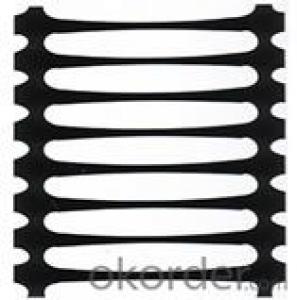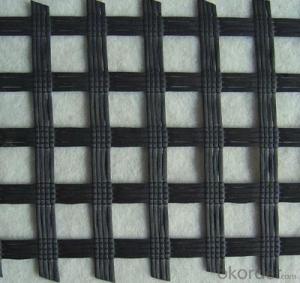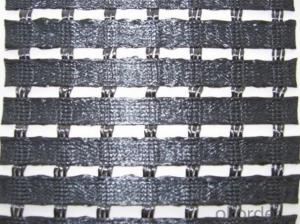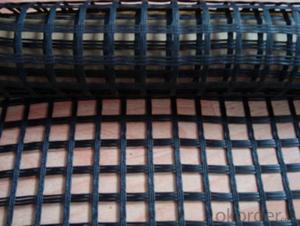Uniaxial Plastics Geo Grid Ppux 50kn/100kn/300kn Retaining Wall Enhancement
- Loading Port:
- Shanghai
- Payment Terms:
- TT OR LC
- Min Order Qty:
- 1000 m
- Supply Capability:
- 150000 m/month
OKorder Service Pledge
OKorder Financial Service
You Might Also Like
Product Introduction
Unixial geogrid is a high-strength geomaterial that uses a polymer as the main raw materials,adds a certain degree of anti-UV,anti-aging agent after stretched in one direction so as to enable the scattered
distribution of chain-shaped molecules re-oriented to lines state.Much better than the traditional or existing reinforced materials,it is a very good reinforced composite materials.
Product Features
1. Unidirectionally high tensile strength, good creep resistance, chemical nature is stable;
2. The friction coefficient with gravel is large.
Product Function
1. Uniaxial geogrid is a king of high-strength structural materials for highways, municipal roads, runways and other subgrade enhancement;
2. It is applied in the enhancement of dam rivers and sea dike;
3. It is applied in the fence of orchards, vegetable, livestock, land, etc. The use is safe and convenient, and conducive to disassembly, elegant appearance;
4. It is applied in the earth retaining and wall reinforcement works and so on;
5. It is mainly used for retaining walls, abutment, slope works an so on;
6. Retaining walls and abutment are force structure which assume all external load: the active earth pressure, the upper part of the structure of the dynamic load, temperature stress and so on, in a larger longterm reinforcement under tension, as well as the effect of repeated dynamic loading, the molecular structure of materials fatigue, occurred in the performance of attention and speed up the aging grid. In order to avoid deformation resulting from reinforcement material creep, it is better to select a high-density polyethylene (HDPE) as raw materials for one-way geogrid.
Product specifications and performance table GB/T17689-1999
Specifications/Item | TGDG25 | TGDG35 | TGDG50 | TGDG80 | TGDG110 | TGDG150 | TGDG170 | TGDG200 | TGDG220 | TGDG240 | TGDG260 | TGDG280 | TGDG300 |
The tensile yield strength of each KN/m≥ | 25 | 35 | 50 | 80 | 110 | 150 | 170 | 200 | 220 | 240 | 260 | 280 | 300 |
Yield elongation %≤ | 10 | ||||||||||||
2% elongation when tensile force KN/M ≥ | 6 | 9 | 10 | 23 | 30 | 39 | 45 | 55 | 59 | 65 | 78 | 84.5 | 90 |
5% elongation when tensile force KN/M≥ | 12 | 18 | 25 | 44 | 60 | 77 | 90 | 110 | 120 | 132 | 157 | 170 | 182 |
Creep limit strength KN/M≥ | 11 | 15 | 21 | 30.2 | 41 | 49 | 57 | 64 | 71.5 | ||||
- Q:Do geogrids have any impact on groundwater?
- Geogrids typically do not have a direct impact on groundwater as they are primarily used for soil stabilization and reinforcement. However, depending on the specific application and design, geogrids can indirectly influence groundwater by improving drainage and reducing soil erosion, which may have positive effects on groundwater recharge and quality.
- Q:The difference between composite geomembrane and bentonite waterproof blanket
- The products of different materials, bentonite waterproof blanket composed of clay minerals and natural material processing machine, high expansibility and high water absorption capacity, moisture permeability is low; the composite geomembrane material is polyethylene particles by calendering equipment to produce plastic film
- Q:How do geogrids improve the performance of geotextile-reinforced slopes?
- Geogrids improve the performance of geotextile-reinforced slopes by providing additional tensile strength and stability to the soil. They act as a reinforcement layer, distributing loads more evenly and preventing excessive soil movement or erosion. This helps to increase the overall strength and integrity of the slope, reducing the risk of failure or collapse.
- Q:What materials are geogrids made of?
- Geogrids are typically made of high-strength polymers, such as polyester or polyethylene, which are woven or knitted to create a grid-like structure.
- Q:Are geogrids resistant to seismic forces?
- Yes, geogrids are designed to be resistant to seismic forces. They are made from durable materials that can withstand the dynamic forces generated during an earthquake, providing stability and reinforcement to soil and structures. Geogrids help distribute seismic forces and prevent soil liquefaction, making them a reliable solution in areas prone to earthquakes.
- Q:How do geogrids improve the stability of earth retaining structures?
- Geogrids improve the stability of earth retaining structures by providing reinforcement and increasing the tensile strength of the soil. They act as a stabilizing element by effectively distributing the loads and reducing the potential for soil movement. Additionally, geogrids enhance the overall performance of these structures by preventing differential settlement and minimizing the risk of wall failure and deformation.
- Q:How do geogrids improve the stability of slopes?
- Geogrids improve the stability of slopes by providing reinforcement and enhancing the overall strength of the soil. They are typically installed within the slope to distribute stress and prevent soil movement, effectively reducing the risk of slope failure. Additionally, geogrids increase the bearing capacity of the soil, allowing for better load distribution and improved stability of the slope.
- Q:What is high strength geogrid
- High strength geogrid grille is actually refers to the large geogrid,
- Q:Are geogrids fire-resistant?
- No, geogrids are not fire-resistant.
- Q:Can geogrids be used in reinforcement of soft ground?
- Yes, geogrids can be used in the reinforcement of soft ground. Geogrids are designed to provide stability and strength to weak or unstable soil, making them ideal for reinforcing soft ground. They are commonly used in various civil engineering applications, such as road and railway construction, to enhance the load-bearing capacity of the soil and prevent ground movement or settlement.
1. Manufacturer Overview |
|
|---|---|
| Location | |
| Year Established | |
| Annual Output Value | |
| Main Markets | |
| Company Certifications | |
2. Manufacturer Certificates |
|
|---|---|
| a) Certification Name | |
| Range | |
| Reference | |
| Validity Period | |
3. Manufacturer Capability |
|
|---|---|
| a)Trade Capacity | |
| Nearest Port | |
| Export Percentage | |
| No.of Employees in Trade Department | |
| Language Spoken: | |
| b)Factory Information | |
| Factory Size: | |
| No. of Production Lines | |
| Contract Manufacturing | |
| Product Price Range | |
Send your message to us
Uniaxial Plastics Geo Grid Ppux 50kn/100kn/300kn Retaining Wall Enhancement
- Loading Port:
- Shanghai
- Payment Terms:
- TT OR LC
- Min Order Qty:
- 1000 m
- Supply Capability:
- 150000 m/month
OKorder Service Pledge
OKorder Financial Service
Similar products
New products
Hot products
Hot Searches
Related keywords






























